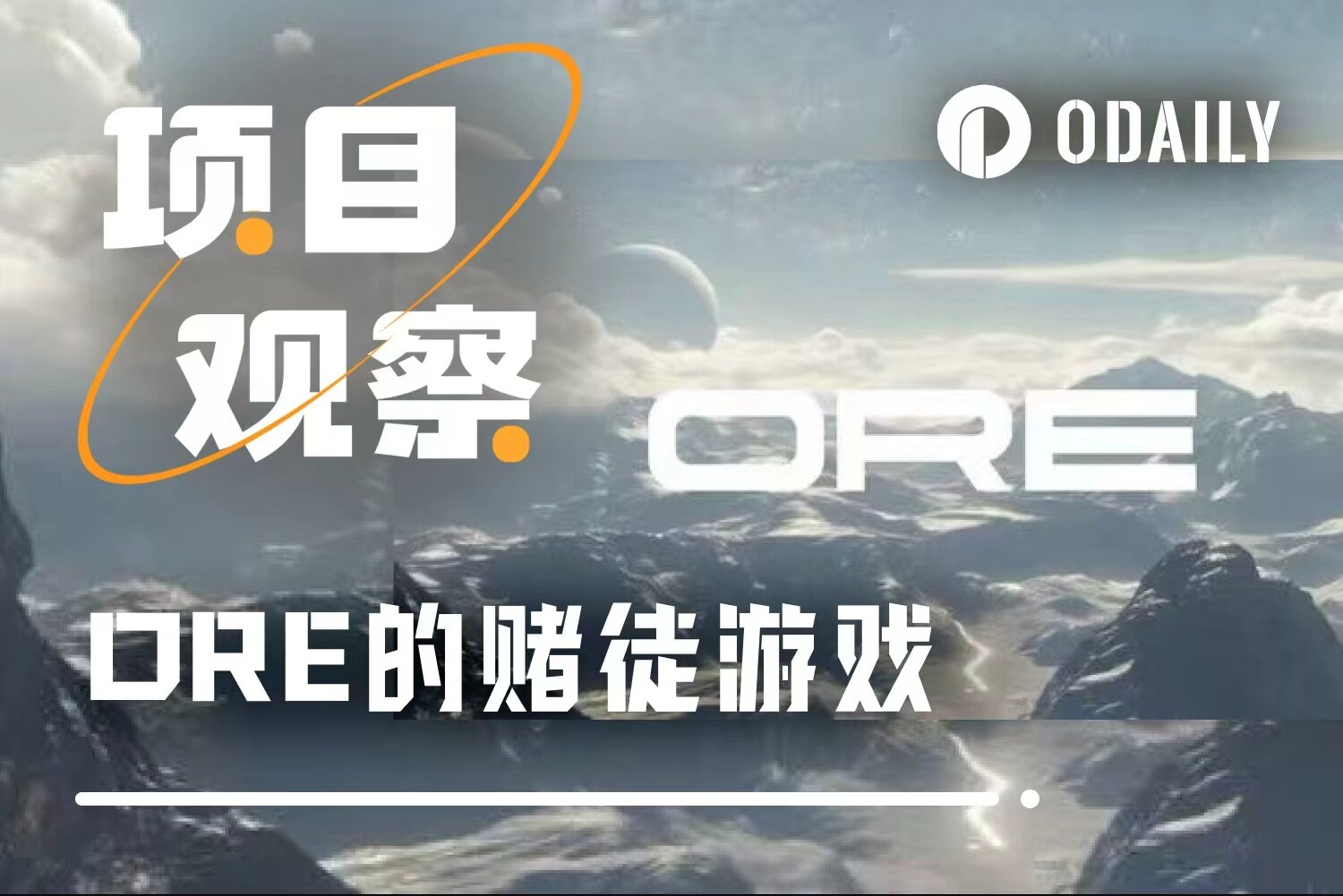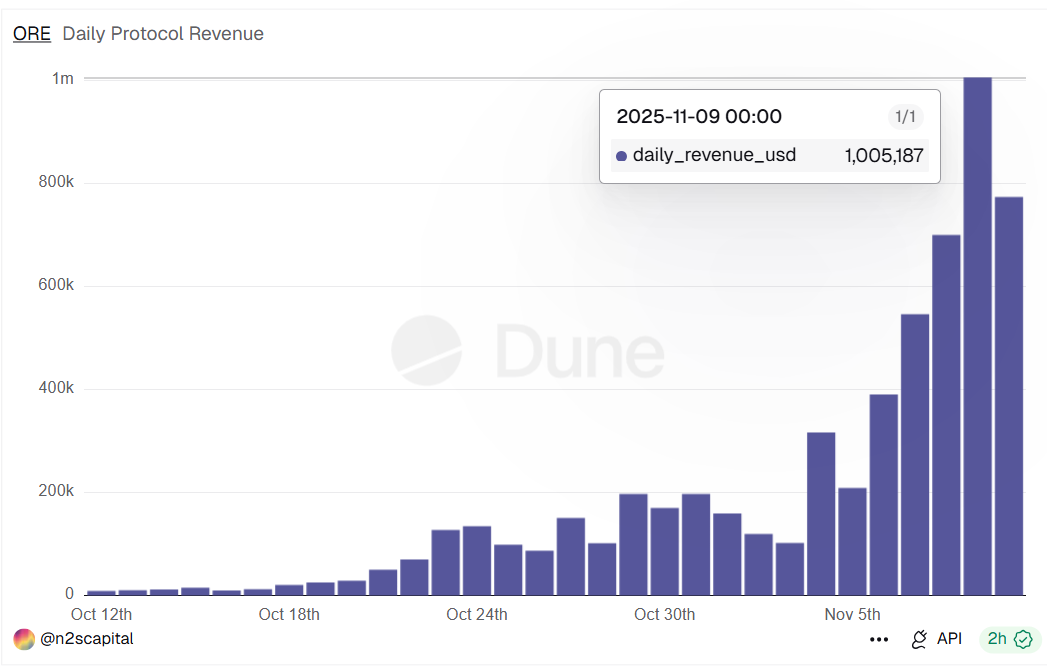Original | Odaily Planet Daily (@OdailyChina)

The monthly increase of ZEC at 137% is no longer impressive, while ORE's monthly increase has reached a staggering 5063%. This project, which skyrocketed from $10 to $540 and saw its market cap soar from $4 million to $200 million, has almost overnight entered the mainstream spotlight. We can't help but ask, what kind of project is this, and what is the foundation of its explosive growth?
Project Origin: Transplanting Bitcoin Spirit to Solana
ORE is a PoW mining protocol on the Solana chain, with the core idea of transplanting Bitcoin's "fair launch, no pre-mining, no distribution mechanism" to the high-performance Solana network, creating a true "digital gold." The project was anonymously developed by founder Hardhat Chad, and this anonymity, low profile, and idealism seem to strive to align with the spirit of crypto fundamentalism.
ORE is not a new project launched this year, but rather a winning project from the 2024 Solana Renaissance hackathon.

In April 2024, ORE made its first attempt to implement PoW mining on Solana. Theoretically, miners need to continuously submit hashes to compete for rewards; however, in a high TPS environment, this "unlimited submission" mechanism led to catastrophic consequences. To increase their chances of winning, professional miners frantically sent transactions, and at that time, Solana was in the midst of a meme craze, creating dual pressure that caused severe network congestion.
ORE-related transactions once accounted for over 25% of the Solana network's capacity, leading to a spike in transaction drops, delays, and failure rates reaching 75%. Consequently, just two weeks after its launch, the founder announced the suspension of mining on April 16, 2024.
This failure became ORE's "turning point." It realized that replicating Bitcoin-style fairness on a high-speed chain was impossible because the computational resources of the chain itself are not infinite—thus, ORE's second restart resembled a rebirth of an economic game.
Gameplay Reconstruction: From PoW to "On-Chain Lottery"
In August 2024, ORE relaunched with version V2 and introduced a new protocol on October 22. It completely abandoned traditional PoW competition and shifted to a "one round per minute" on-chain lottery mechanism.
The basic gameplay involves a 5×5 grid with 25 squares, where miners use SOL as a stake to "prospect" (occupy space) on the squares, allowing for multiple squares and repetitions (minimum 0.1 SOL/square). At the end of each round, the system randomly selects a "winning square" using Solana's official VRF (Verifiable Random Function). All miners in the winning square share the SOL from all losing squares of that round + 1 newly issued ORE proportionally. In about half of the rounds, the system will randomly select 1 miner to receive the entire +1 ORE, while the other winners only share the SOL.
It is important to note that the protocol will charge a 10% fee on the total SOL bet of that round, which is entirely used to repurchase ORE from the market, with 90% directly burned and 10% distributed to ORE stakers, rewarding long-term holders.
In addition, the protocol has added a Motherlode gameplay. Each round, a fixed amount of +0.2 ORE is minted and added to the Motherlode prize pool; there is a 1/625 chance (averaging once every 3 rounds) of triggering the Motherlode, where all miners in the winning square share the entire prize pool proportionally based on their occupied space; if not triggered, it continues to accumulate (the current prize pool has accumulated 256 ORE, valued at approximately $97,000 based on the current price of $380).
Moreover, all mining rewards in ORE are by default unclaimed, so claiming incurs a 10% fee, which is redistributed to other miners who have not claimed. This means that the earlier you sell, the more you lose; the later you sell, the more you gain.
Additionally, if you hold ORE, you can stake it on the official website, where the amount staked determines your mining multiplier (betting weight), with a maximum of 2x, reinforcing the positive feedback for holding coins.
From a mechanism perspective, ORE has designed multiple layers at the behavioral finance level, combining "delayed gratification," "group incentives," and "deflationary narrative," creating a psychological loop that aligns token holders with gamblers.

Token Economics: Deflation and Scarcity Narrative
The maximum supply cap for ORE tokens is 5 million, with a current circulation of 412,000, accounting for approximately 8.2% of the total supply. All tokens are minted programmatically controlled by smart contracts on the Solana blockchain, with no pre-mining or pre-allocation, returning to the original vision of Bitcoin's fair distribution. In an era of oversupply in the tens of billions, scarcity has become a unique narrative weapon.
More critically, 10% of protocol revenue is fully used for buybacks and burns, creating a flywheel effect of "the more people play, the more is burned, the scarcer it becomes." According to Dune data, since the protocol's launch, revenue has gradually increased. On November 9, it ranked second in Solana network revenue, with daily earnings exceeding one million dollars, second only to Pump.fun.

We can see that in the past 24 hours, the ORE protocol's daily revenue was $870,000, and the net supply of tokens (newly minted tokens - burned tokens) decreased by 256. Based on the current protocol revenue, the daily deflation value of the tokens is approximately $97,000. 
This means that ORE has effectively constructed a "self-reinforcing deflationary mechanism": the hotter the protocol, the stronger the speculation, the more buybacks occur, and the higher the price expectations—thus attracting more speculators. Deflation is no longer just a monetary attribute but a emotion-driven price narrative.
Flywheel Model: Gambling, Deflation, and Ecological Binding
From an economic logic perspective, ORE is essentially a system that tightly binds "gambler's impulse + deflation expectation + Solana's native demand."
The first step of the flywheel is to ignite the "gambler's impulse." From the data above, we can see that after November 5, ORE's protocol revenue suddenly surged. The direct catalyst was the launch of its mobile application, Solana Mobile Seeker—users no longer needed a computer or command line but could mine with a single click on their phones. The sudden drop in barriers led to explosive growth: the number of miners increased more than tenfold, and the betting amount per round skyrocketed from a few SOL to over sixty SOL.
As the miner base expanded, protocol revenue rapidly climbed. According to the mechanism design, 10% of each round's bets are extracted for market buybacks and ORE burns. With a total token supply of only 5 million and a circulation of less than 8%, hundreds of ORE are net burned daily, creating strong scarcity expectations. This is also the second layer of the flywheel's power: the consensus of the deflation narrative. In the model of "the more people play, the more is burned, the scarcer it becomes," scarcity itself becomes the reason for participation.
The third layer of power comes from ecological binding. All bets in ORE are priced in SOL, meaning that each "bet" increases the demand for SOL and on-chain activities. As transactions increase, the fees and validator income on the Solana network rise in tandem, creating a broader ecological positive feedback loop. In a sense, ORE is not just an independent protocol but an ecological accelerator amplified through "on-chain behavioral finance." This is precisely what the Solana ecosystem currently anticipates.
Furthermore, the existence of the Motherlode prize pool and the staking weight mechanism further reinforces the positive feedback of speculation. The former provides FOMO stimulation with "sudden jackpots," while the latter rewards long-term holders with staking multipliers, making short-term selling behavior subject to both psychological and profit pressures. Thus, the intertwining of gambler's greed, deflationary faith, and ecological resonance creates a seemingly perfect closed loop.
Currently, ORE's daily revenue can outperform most L1s, yet its circulating supply is only 8%. As long as miners are willing to bet SOL that tomorrow will be more expensive, this flywheel will continue to accelerate. However, the charm of the flywheel is also its fragility. Because the ORE protocol itself does not generate value; it merely allows participants to voluntarily "produce scarcity" through mechanism design. However, if large holders collectively take profits or the Motherlode is not triggered for an extended period, FOMO sentiment will cool, and the flywheel will be dismantled.
The story of ORE may not be over yet. In a sense, ORE's explosive growth is not just a victory of mechanism but also a victory of human nature. Under the narrative shell of "replicating the spirit of Bitcoin," it has constructed a complex system that integrates mining, lottery, deflation, and FOMO.
But like all emotion-driven flywheels, it can both excite and potentially collapse overnight.
免责声明:本文章仅代表作者个人观点,不代表本平台的立场和观点。本文章仅供信息分享,不构成对任何人的任何投资建议。用户与作者之间的任何争议,与本平台无关。如网页中刊载的文章或图片涉及侵权,请提供相关的权利证明和身份证明发送邮件到support@aicoin.com,本平台相关工作人员将会进行核查。



